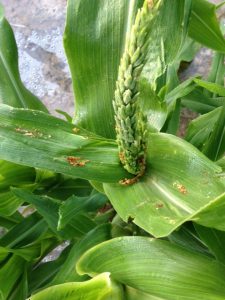Sweet Corn
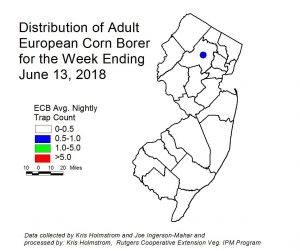 European corn borer (ECB) moths have declined in black light traps, and numbers are now very low. The highest activity now in central Morris County (see ECB map). As is normal, when the adult generation winds down, feeding increases. IPM technicians have reported dramatic increases in feeding in whorl and pre-tassel stage plantings in the all counties. Numbers of infested plants have exceeded 30% in many areas. Look for the characteristic “shot-hole” type of feeding (photo below at right) and consider treating when
European corn borer (ECB) moths have declined in black light traps, and numbers are now very low. The highest activity now in central Morris County (see ECB map). As is normal, when the adult generation winds down, feeding increases. IPM technicians have reported dramatic increases in feeding in whorl and pre-tassel stage plantings in the all counties. Numbers of infested plants have exceeded 30% in many areas. Look for the characteristic “shot-hole” type of feeding (photo below at right) and consider treating when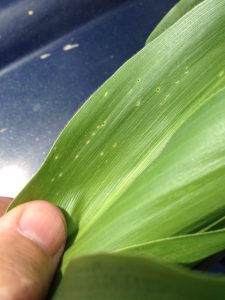 infested plants exceed 12% in a 50 plant sample. As infested plants proceed to the pre-tassel stage, live larvae and damage may be found in the emerging tassels (see bottom photo at left). Once plants hit full tassel, ECB larvae will move downward on the stalk and re-enter the plant near the area where ears are forming. This can result in direct injury to the ear. Growers should consider an insecticide application at the full tassel stage to target ECB larvae as they migrate downward. This application can eliminate larvae that have escaped any earlier insecticide applications.
infested plants exceed 12% in a 50 plant sample. As infested plants proceed to the pre-tassel stage, live larvae and damage may be found in the emerging tassels (see bottom photo at left). Once plants hit full tassel, ECB larvae will move downward on the stalk and re-enter the plant near the area where ears are forming. This can result in direct injury to the ear. Growers should consider an insecticide application at the full tassel stage to target ECB larvae as they migrate downward. This application can eliminate larvae that have escaped any earlier insecticide applications.
The highest nightly trap catches of ECB for the week ending 6/13/18 are as follows:
| Belvidere 1 | Downer 1 | Hillsborough 1 |
| Califon 1 | East Vineland 1 | Little York 1 |
| Clinton 1 | Georgetown 1 | Milford 1 |
| Denville 1 | Hackettstown 1 | Sergeantsville 1 |
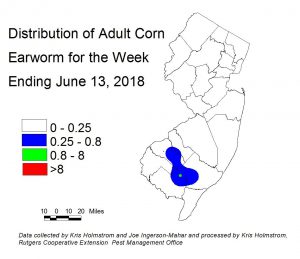 Corn earworm (CEW) moths have been captured in greater numbers this past week (see CEW blacklight map at left) . While these numbers are low, early plantings in southern NJ now at or near silk stage are at elevated risk of infestation. In addition, the CEW pheromone trap network in the southern counties has also registered significant catches (see CEW pheromone trap map at lower right). The pheromone network trap is much more sensitive than the blacklight trap, particularly for this spring
Corn earworm (CEW) moths have been captured in greater numbers this past week (see CEW blacklight map at left) . While these numbers are low, early plantings in southern NJ now at or near silk stage are at elevated risk of infestation. In addition, the CEW pheromone trap network in the southern counties has also registered significant catches (see CEW pheromone trap map at lower right). The pheromone network trap is much more sensitive than the blacklight trap, particularly for this spring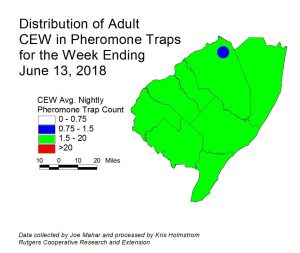 flight. For this reason, an increase in moths in the pheromone traps does not directly correspond to the schedule prescribed by the blacklight traps. Additionally, there are many fewer pheromone traps than blacklight traps. This results in much broader colored patches on the pheromone maps. The green area on the pheromone map indicates a 4-5 day silk spray schedule. We typically get a short term increase in CEW moths early in June when southerly breezes move them here. This sporadic activity generally subsides in the second half of the month through mid-July.
flight. For this reason, an increase in moths in the pheromone traps does not directly correspond to the schedule prescribed by the blacklight traps. Additionally, there are many fewer pheromone traps than blacklight traps. This results in much broader colored patches on the pheromone maps. The green area on the pheromone map indicates a 4-5 day silk spray schedule. We typically get a short term increase in CEW moths early in June when southerly breezes move them here. This sporadic activity generally subsides in the second half of the month through mid-July.
The highest nightly black light trap catches of CEW for the week ending 6/13/18 are as follows:
| Downer 1 | Elm 1 | Medford 1 |
| East Vineland 1 | Folsom 1 |
The highest nightly pheromone trap catches of CEW for the week ending 6/13/18 are as follows:
| Woodstown 10 | Beckett 8 | Elm 4 | Berlin 2 |
| Monroeville 9 | Pedricktown 7 | Belvidere (Warren Co) 3 | Jobstown 2 |
Silking Spray Schedules*:
South – 4 days
Central – 6 days
North – 6
*These recommendations are based on regional catches. Adhere to tighter spray schedules if indicated by local trap catches.
Peppers
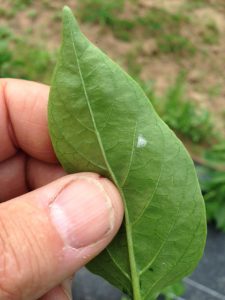 With declining ECB moth activity, growers should be looking for ECB egg masses (see photo at left) on the underside of pepper leaves. The larvae that hatch from these eggs will bore into the central stem of pepper plants in the absence of suitable fruit. This damage causes the tops of the plant to die, and eliminating the crown set of fruit in the process. Check 2 leaves per plant on 5 consecutive plants in 10 random locations. Consider treating if 2 or more leaves are found to have ECB larvae on the lower surface.
With declining ECB moth activity, growers should be looking for ECB egg masses (see photo at left) on the underside of pepper leaves. The larvae that hatch from these eggs will bore into the central stem of pepper plants in the absence of suitable fruit. This damage causes the tops of the plant to die, and eliminating the crown set of fruit in the process. Check 2 leaves per plant on 5 consecutive plants in 10 random locations. Consider treating if 2 or more leaves are found to have ECB larvae on the lower surface.
Pepper Weevil
One weevil was trapped this week at a non-field location in the Hammonton area. As far as known, there are no infested fields at this time.
Tomatoes
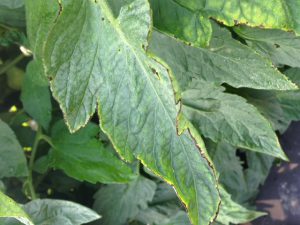 Field scouting of outdoor and high tunnel tomatoes continues. Bacterial leaf spot infections (see photo at left) have begun to appear in some fields following heavy rains. Look for very dark lesions on leaf margins, and on the interior of immature leaves. Lesions will have chlorotic borders and may cause immature leaves not to expand properly. Growers should treat preventively for this disease prior to symptoms. See the tomato section of the 2018 Commercial Vegetable Recommendations Guide for materials and spray schedules.
Field scouting of outdoor and high tunnel tomatoes continues. Bacterial leaf spot infections (see photo at left) have begun to appear in some fields following heavy rains. Look for very dark lesions on leaf margins, and on the interior of immature leaves. Lesions will have chlorotic borders and may cause immature leaves not to expand properly. Growers should treat preventively for this disease prior to symptoms. See the tomato section of the 2018 Commercial Vegetable Recommendations Guide for materials and spray schedules.
Brown marmorated stink bug (BMSB)
BMSB catches in black light traps have declined everywhere this past week and no map will appear in this edition. Although this pest has not had serious impact on vegetable crops like peppers in recent years, it is still a significant pest of tree fruits.
The highest nightly trap catches of BMSB for the week ending 6/06/18 are as follows:
| Allentown 2 | Crosswicks 1 | Medford 1 |
| Farmingdale 2 | Georgetown 1 | Old Bridge 1 |
| Califon 1 | Hillsborough 1 | South Branch 1 |
| Centerton 1 | Matawan 1 | Woodstown 1 |
2018 Vegetable IPM Program Personnel
Kris Holmstrom and Joe Ingerson-Mahar would like to acknowledge the IPM Field Technicians for this season:
Justine Cieslik
James Duffy
Dylan McCollough
Nancy Michaelsen
Ryan Tirrell
Luann Winters
Without the assistance of these individuals, much of the information presented in this publication would be unobtainable. We are grateful for all their help and hard work.
